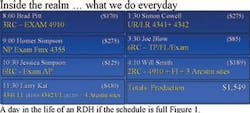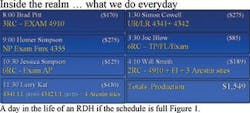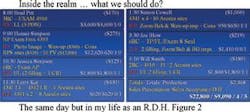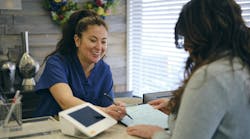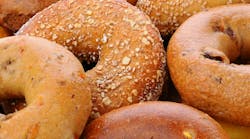Inside & outside the realm
How hygiene can help your practice grow.
Do you know what you need to have a really profitable hygiene department that delivers excellence? The first thing the department needs is a realistic modus operandi. Next is a sound set of goals and the help and support to obtain those goals.
I am living proof that a thriving hygiene department can have a major influence on the success of a dental practice. Not only are hygiene services important to patients’ health, they are essential for the practice. The hygiene department generates revenues and creates referral opportunities, dental sales, patient retention, and practice growth.
Time is money
Because hygienists are both service providers and profit producers, the time they spend with their patients is very valuable. Being unable to produce to their fullest potential could be extraordinarily expensive to the business in ways we haven’t even thought of.
To get the most out of the time a hygienist spends with a patient, it is important to have a focused agenda, clearly defined goals, and a workable system. It is not about cramming more work into less time during an appointment, but about getting the best use of the hygienist’s time with the patient.
Let’s examine specific strategies for creating what should be the foundation for any successful hygiene program.
Inside the realm: redefining hygiene
A realistic way to evaluate hygiene’s profitability is to look at the blend of procedures and associated fees that are offered as actual production. Examples include all the traditional preventive services and appropriate periodontal procedures, radiographs, sealants, and health-care products as seen in Figure 1.
Also included in most hygienists’ days, but rarely shown as actual production for hygiene, is the preliminary examination conducted by the hygienist with an intraoral camera or digital photography. Don’t forget the prediagnostic treatment plan and discussion of potential care. Tracking these elusive numbers can be tricky. I have found that the best way to track these numbers is to incorporate them into the daily goals.
Know the daily goals
The scheduled goal, for both daily production and the next hygiene visit, should not be the only considerations in a hygiene day. Today’s progressive hygiene departments have daily sales presentations and sales acceptance goals for which they are responsible.
For example, my daily hygiene production goal is $1,800, and most days exceed that goal. My sales presentation goal (esthetics, quadrant, or comprehensive dentistry that is presented from my hygiene chairs) is $5,000 per day, and my sales acceptance goal (accepted financials secured and scheduled) is $3,500 per day as seen in Figure 2.
These goals are obtained by simply adding my daily hygiene production goals to my doctor’s daily production goals.
Track the treatment plan that was discussed from the hygiene chair by writing it next to the patient’s name on the day sheet. For example: lower right #31MO (inlay - $1,100), #30MOD (porcelain crown - $1,100), #29MOD (inlay - $1,100), #28DO (two surface direct - $250, or inlay $1,100). Estimated total: $4,500.
It’s easy to call everything a restoration. You can say to the patient, “We will be restoring the lower right side on the next visit. If we can have a moment of your time, we can explain the fee for your treatment and the payment options we have available. Let’s see what’s most convenient for you.” You can then escort the patient into the private consultation room where the financial coordinator is waiting to complete the process.
In addition, the daily retention rate needs to be tracked for both the doctor and hygienist. Did the patient schedule his or her next visit? I consider any patient not scheduled for an appointment inactive, so tracking these numbers is critical to the health of the business. Your goal should be to have all patients walk out with at least their next two appointments scheduled. Attainment of all goals is shown in Figure 3.
In order for the hygiene department to obtain these goals, we have a full-time hygiene treatment coordinator, two rooms dedicated to hygiene, and a scheduler who is attentive to the hygiene schedule. Years ago, I helped my doctors and the scheduler understand that if the hygiene schedule was not full today, the doctor’s schedule would not be full tomorrow.
Outside the realm … what else can we do?
Another profit area in the hygiene department should be taking impressions for whitening procedures and their associated products - bite-splints, sports-guards, snore appliances, diagnostic study models, and diagnostic cosmetic wax-ups. Adding these procedures can increase production substantially as seen in Figure 3.
I find taking alginate impressions to be agonizing in both time and procedure. First, what hygienist has the time to take impressions, especially if the patient needs them for two different procedures such as take-home whitening trays and a diagnostic cosmetic wax-up?
There are so many things that can go wrong with taking alginate impressions, such as wondering if we mixed the proper ratio of alginate to water, or hoping the water temperature was accurate before it set. Having to pour the alginate immediately before the impression distorts or causes dimensional changes gives me such a distaste that I haven’t taken an alginate impression since my graduation in 1976.
There are some great products (Status Blue - Zenith Dental, Alignot - Kerr, Quick Step - 3M/ESPE, to name a few) that deliver excellent impressions without much hassle. All of these materials have good working time, remove the guesswork, delay pouring, and do not distort. Personally, I recommend StatusBlue®, an A-silicone alginate substitute formula that captures great impression detail, sets quickly, and provides complete dimensional stability. It is a 100 percent dust-free impression material that is stable in any working environment, so the annoying white powder no longer gets everywhere.
Where alginate impressions can only be poured once, this alginate alternative can be poured over and over and reused indefinitely for up to three months, all from the original impression. With this, we can now use one impression - the same one for today’s diagnostic study models and tomorrow’s cosmetic wax-ups, bite splints, orthotics, snore appliances, sports guards, whitening trays, and making or remaking temporaries. Its smooth surface allows exact models and minimizes the effort to trim while producing temporaries.
Less hand fatigue is very important to all auxiliaries. Because StatusBlue comes in automix cartridges for its MixStar system or convenient hand-held guns, there is no more mixing and no bowls and spatulas to clean up. The MixStar machine is placed in a central area in our office for the doctor to use. We store the hand-held guns and cartridges in each room for the times when patients say yes. ■
Deborah Dopson-Hartley, RDHMs. Dopson-Hartley is known as one of the most profitable hygienists in the country, as well as an international speaker and consultant. She practiced full-time dental hygiene for more than 28 years. She has authored numerous articles for many leading dental publications. Contact her at (813) 541-6225 or visit www.deborahhartley.com.
